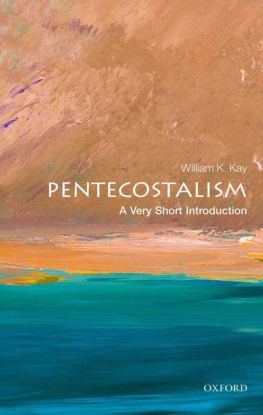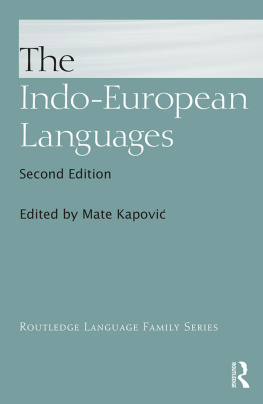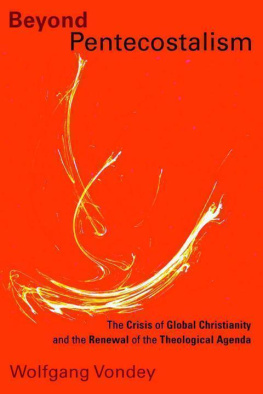European Pentecostalism
Its Origins, Development, and F uture
European Pentecostalism
Its Origins, Development, and Future
Paul Schmidgall

CPT Press
Cleveland, Tennessee
European Pentecostalism
Its Origins, Development, and Future
Published by CPT Press
900 Walker ST NE
Cleveland, TN 37311
USA
email: cptpress@pentecostaltheology.org
website: www.cptpress.com
Library of Congress Control Number: 2011933496
ISBN-10: 1935931199
ISBN-13: 9781935931195
Copyright 2013 CPT Press
All rights reserved. No part of this book may be reproduced or translated in any form, by print, phot oprint, microfilm, microfiche, electronic database, internet database, or any other means without written permission from the publisher.
Contents
Introduction
Worldwide Spread of Pentecostalism
2.1 America
2.2 Africa
2.3 Asia
2.4 Australia
2.5 Europe
2.6 Pentecostal World Conference (PWC)
European Pentecostalism
3.1 Fathers of European Pentecostalism
3.1.1 Edward Irving (1792 1834) 15
3.1.2 Thomas Ball Barratt (1862 1940) 17
3.2 European Pentecostalism Organization 21
3.2.1 Pentecostal European Fellowship (PEF)
3.2.2 Pentecostal European Mission (PEM)
3.2.3 European Pentecostal Theological Association
3.3 European Pentecostalism Theology 25
3.3.1 Lukes Distinctive Pneumatology 27
3.3.2 Biblical Theology 29
3.3.3 Systematic Theology 31
3.4 European Pentecostalism Missiology 35
3.5 European Pentecostalism Sociology 39
3.6 European Pentecostalism Political Theology 44
3.7 European Pentecostalism Ecumenism 50
3.8 Expansion of European Pentecostalism
3.8.1 Before World War I: Early Beginnings 56
3.8.2 Between the Wars: Formation of Denominations 57
3.8.3 The Challenge of the Charismatic Movement 57
3.8.4 In Dialogue with the Third Wave Movement 58
3.8.5 The Revival Movement 58
Pentecostalism in Great Britain & Ireland
4.1 History 60
4.1.1 Early Beginnings 60
4.1.2 Apostolic Church 61
4.1.3 Elim Pentecostal Church 62
4.1.4 Assemblies of God 62
4.1.5 New Testament Church of God 63
4.1.6 Church of God of Prophecy 64
4.1.7 The British Pentecostal Fellowship (BPF) 64
4.2 Statistics 66
4.2.1 Great Britain
4.2.2 Ireland
4.3 Bibliography 67
Pentecostalism in Scandinavia
5.1 Denmark 73
5.2 Finland 77
5.3 Iceland
5.4 Norway 90
5.5 Sweden 99
Pentecostalism in Central Europe
6.1 Austria 104
6.2 Belgium 108
6.3 France
6.4 Germany
6.5 Holland 147
6.6 Luxembourg 152
6.7 Switzerland 154
Pentecostalism in Eastern Europe
7.1 Albania & Kosovo 159
7.2 Belarus
7.3 Bosnia & Herzegovina 164
7.4 Bulgaria 167
7.5 Croatia
.6 Czech Republic 176
7.7 Estonia 180
7.8 Hungary 183
7.9 Latvia 188
7.10 Lithuania
7.11 Macedonia
7.12 Moldova 199
7.13 Poland 203
7.14 Romania 208
7.15 Russia 217
7.16 Slovak Republic
7.17 Serbia & Montenegro
7.18 Slovenia 242
7.19 Ukraine 246
Pentecostalism in Southern Europe
8.1 Cyprus 250
8.2 Greece 253
8.3 Italy 258
8.4 Malta 265
8.5 Portugal 267
8.6 Spain 273
Outlook : Quo Vadi s European Pentecostalism?
9.1 Glossolalia
9.2 Experience & Spirituality 287
9.3 Globalization
Appendices 296
10.1 Statistical Summary by Countries 296
10.2 Statistical Summary by Sections 298
10.3 Maps of Europe 299
10.3.1 Evangelical Population of Europe (%)
10.3.2 Pentecostal/Charismatic Population of Europe 300
10.3.3 Pentecostal/Charismatic Population of Europe (%)
10.3.4 Pentecostal Population of Europe 302
10.3.5 Pentecostal Population of Europe (%)
I ndex of Biblical References 304
Index of Names 305
Introduction
For many years the historiography of European Pentecostalism has basically been limited to the work of two writers: Nils
Worldwide Spread of Pentecostalism
Despite the media setbacks suffered by the Pentecostals in the 1980s due to the television evangelists scandals, there is a continuing trend towards growth around the world. In his demographic studies, David Barrett reported lately even stronger growth than most experts suspected. Barrett and Synan, the worlds leading experts on Pentecostal growth, quoted the following numbers for the turn of the millennium:
World Population 6,010,779,000
Christians 1,990,018,000
Roman Catholics 1,040,020,000
Pentecostals /Charismatics 536,000,000
Anglicans 73,200,000
Baptists 59,600,000
Lutherans 57,700,000
Presbyterians 49,800,000
Assemblies of God 34,500,000
Methodists 33,000,000
The 536 million Pentecostals and Charismatics worldwide can be subdivided in three main categories:
Classical Pentecostals 66,000,000
Charismatics 175,000,000
Th ird Wavers/Neocharismatics 295,000,000
The distribution of Classical Pentecostals on the five continents is reflected in the list below:
Africa 15, 000,000
Asia 9,500,000
Australia: 500,000
Europe : 3,000,000
North America: 5,000,000
South America: 33,000,000
 The worldwide sociological breakdown of Pentecostalism can be summarized as follows: More members live in cities than in rural areas; there are more women than men, more children than adults; more belong to the majority world (66%) rather than to the western world; and many live in poverty (87%) and are non-white (71%) .
The worldwide sociological breakdown of Pentecostalism can be summarized as follows: More members live in cities than in rural areas; there are more women than men, more children than adults; more belong to the majority world (66%) rather than to the western world; and many live in poverty (87%) and are non-white (71%) .
2.1 America
In spite of the fact that in research on worldwide Penteco stalism it becomes more and more obvious that there were several awakenings around 1900,
South America also experienced revivals at the beginning of the twentieth century. Chile, Brazil, and Argentina (1910), Peru (1911), Nicaragua (1912), Mexico (1914), Guatemala, and Puerto Rico (1916) had early Azusa Street experiences of their own that resulted in drastic growth.
2.2 Africa
In Africa , the number of Christians south of the Sahara has grown from ten million at the beginning of the twentieth century to about 350 million by the year 2000, which is an increase from 8% to 50% of the population.
Even in the secular media, some of the Pentecostal leaders are well known. For example, the best-known German in Africa is the Pentecostal evangelist Reinhard Bonnke. In his open-air healing crusades he has preached to hundreds of thousands throughout the continent. I learned of his great popularity in Africa during a seminar held in the Sedamo Valley in Ethiopia. I asked the participating pastors for the name of the Chancellor of Germany, who was then Helmut Kohl. Over 90% were not able to produce his name. On the other hand, when asked about evangelist Reinhard Bonnke over 90% were not only familiar with his name, but many of them had actually been in one of his crusades. It is also interesting to note that Ethiopia has the fastest growing Lutheran church in the world, the Mekane Jesus Church. One secret of its growth is that it is Pentecostal in its orientation. The influence of Pentecostalism in Ethiopia has become so strong that Protestant believers in the country are at times simply referred to as Pentecostals.
2.3 Asia
Next page









 The worldwide sociological breakdown of Pentecostalism can be summarized as follows: More members live in cities than in rural areas; there are more women than men, more children than adults; more belong to the majority world (66%) rather than to the western world; and many live in poverty (87%) and are non-white (71%) .
The worldwide sociological breakdown of Pentecostalism can be summarized as follows: More members live in cities than in rural areas; there are more women than men, more children than adults; more belong to the majority world (66%) rather than to the western world; and many live in poverty (87%) and are non-white (71%) .